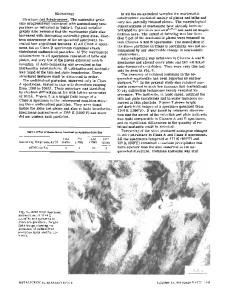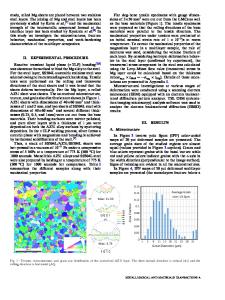Heterogeneous Microstructure of Low-Carbon Microalloyed Steel and Mechanical Properties
- PDF / 2,446,730 Bytes
- 7 Pages / 593.972 x 792 pts Page_size
- 118 Downloads / 394 Views
JMEPEG https://doi.org/10.1007/s11665-020-05217-7
Heterogeneous Microstructure of Low-Carbon Microalloyed Steel and Mechanical Properties S. Fida Hassan
and H. Al-Wadei
(Submitted July 9, 2020; in revised form 23 September, 2020) The microstructure plays a major role in the performance of metallic materials, which can be tailored through the composition and/or processing technique. In this study, a heterogeneous microstructure was developed for low-carbon microalloyed API X65 steel, the most commonly used pipeline steel for oil and gas transportation, using a heat treatment process. The heat treatment process involved intercritical heating of the steel followed by high-temperature isotheral cooling, allowing for phase transformation, as well as alloying element partitioning. The heat treatment transformed the banded ferrite–pearlite microstructure of rolled steel to a quasi-polygonal ferrite microstructure, with the sporadic presence of austenite at the grain boundaries. The quasi-polygonal ferrite was distributed in a heterogeneous form with a fine-grain shell surrounding the coarse-grained core. The heterogeneity in the microstructure, despite being single phase, led to a significant improvement in the tensile yield strength, ultimate tensile strength, ductility and toughness of the steel, with a marginal reduction in microhardness values. Keywords
API X65, heat treatment, heterogeneous, microalloyed Steel, pipeline, strength, toughness
1. Introduction The strength–ductility combination simultaneously improves in the metallic material when the microstructure is heterogeneous (Ref 1-3), which is anomalous to most of their counterparts with a homogeneous microstructure. The heterogeneous microstructure is built up with the regular repetitive positioning of ÔdomainsÕ with different microstructural features (in terms of size, geometry and/or phases), while the domain possesses different levels of strength. The applied external stress induces inhomogeneous deformation in the domains and results in the development of strain gradients at and around the domain boundaries (Ref 1, 4). Geometrically necessary dislocations are generated (Ref 1, 5) to accommodate this straingradient necessitate, which is concentrated around the domain boundaries. The applied stress also induces stress partitioning between the ÔdomainsÕ with a large grain-size difference (Ref 1, 6). The geometrically necessary dislocation and stress partitioning inevitably resist the homogeneous deformation by creating long-range back-stress around the domain boundaries, resulting in extraordinary simultaneous enhancement in the strength and ductility of the metallic materials. This microstructural heterogeneity can be derived from the inhomogeneity in
S. Fida Hassan and H. Al-Wadei, Department of Mechanical Engineering, King Fahd University of Petroleum & Minerals, P.O. Box 1061, Dhahran 31261, Kingdom of Saudi Arabia. Contact e-mails: [email protected] and itsforfi[email protected].
Journal of Materials Engineering and Performance
the microstructural fea
Data Loading...











